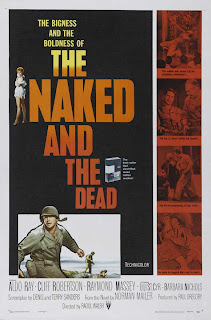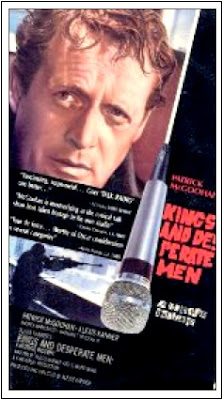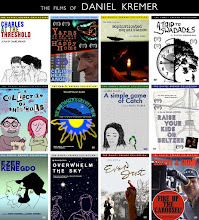BEST DVD RELEASES OF 2009
 1. Jeanne Dielman, 23 Quai de Commerce, 1080 Bruxelles (Region 1) Pound for pound, Criterion’s release of Chantal Akerman’s masterpiece is the best DVD package of the year. The transfer looks crisp and vibrant, and the extras, which include interviews with the cinematographer (Babette Mangolte as of late has become my favorite cinematographer) and the director’s mother, which is an extraordinary interview with an extraordinary woman and justifies being a film in and of itself. I will be among the first to line up for Criterion’s release of the Chantal Akerman in the 70’s Eclipse set. If the transfers are anywhere near as good as the one for Jeanne Dielman, I am in for a very big treat. I can’t wait!
1. Jeanne Dielman, 23 Quai de Commerce, 1080 Bruxelles (Region 1) Pound for pound, Criterion’s release of Chantal Akerman’s masterpiece is the best DVD package of the year. The transfer looks crisp and vibrant, and the extras, which include interviews with the cinematographer (Babette Mangolte as of late has become my favorite cinematographer) and the director’s mother, which is an extraordinary interview with an extraordinary woman and justifies being a film in and of itself. I will be among the first to line up for Criterion’s release of the Chantal Akerman in the 70’s Eclipse set. If the transfers are anywhere near as good as the one for Jeanne Dielman, I am in for a very big treat. I can’t wait!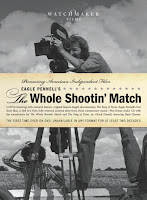 2. The Whole Shootin’ Match (Region 1) Watchmaker Films’ release of Eagle Pennell's recently resurrected independent classic of regional filmmaking is compulsory viewing for anyone who has made or wishes to make a movie on the cheap, to make it good and to live to tell about it. The release of this film on DVD inspired its own article on the blog many months ago. To read it, click here. The 2-disc special edition also features Pennell's first short film, A Hell of a Note, along with a rare interview with the director and a soundtrack for the film. Rumor has it that a Watchmaker Films DVD release of Pennell's Last Night at the Alamo (1983) is in the works. One can only hope that they do as fine a job with that one as they've done with this one.
2. The Whole Shootin’ Match (Region 1) Watchmaker Films’ release of Eagle Pennell's recently resurrected independent classic of regional filmmaking is compulsory viewing for anyone who has made or wishes to make a movie on the cheap, to make it good and to live to tell about it. The release of this film on DVD inspired its own article on the blog many months ago. To read it, click here. The 2-disc special edition also features Pennell's first short film, A Hell of a Note, along with a rare interview with the director and a soundtrack for the film. Rumor has it that a Watchmaker Films DVD release of Pennell's Last Night at the Alamo (1983) is in the works. One can only hope that they do as fine a job with that one as they've done with this one.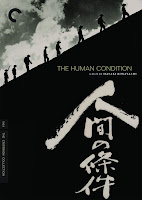 3. The Human Condition (Region 1) Long available only in three separate heavily compressed barebones Image Entertainment releases with poor transfers, the Criterion Collection saves the day once again and delivers not just an excellent transfer of this nine-hour-plus Japanese masterpiece but also rare interviews with its filmmaker Kobayashi and the actor Tatsuya Nakadai. This is epic filmmaking to say the very, very least.
3. The Human Condition (Region 1) Long available only in three separate heavily compressed barebones Image Entertainment releases with poor transfers, the Criterion Collection saves the day once again and delivers not just an excellent transfer of this nine-hour-plus Japanese masterpiece but also rare interviews with its filmmaker Kobayashi and the actor Tatsuya Nakadai. This is epic filmmaking to say the very, very least. 4. A Time to Love and a Time to Die (Region 2) Douglas Sirk has long been a contentious director for me, causing many a heated debate between me and his staunch defenders who say I’m either crazy or am missing something, or both (I was and am still outnumbered). This film, however, one of the few of his not currently available in the United States, held up due to American rights issues, is not just my favorite Sirk film, but also one of my favorite films period, and certainly the best melodrama to come out of the Hollywood machine at that time. It comes to DVD from Eureka!’s “Masters of Cinema” Collection, known to video-monsters stateside as the British Criterion Collection. It also may be one of the most ambitious war films on record.
4. A Time to Love and a Time to Die (Region 2) Douglas Sirk has long been a contentious director for me, causing many a heated debate between me and his staunch defenders who say I’m either crazy or am missing something, or both (I was and am still outnumbered). This film, however, one of the few of his not currently available in the United States, held up due to American rights issues, is not just my favorite Sirk film, but also one of my favorite films period, and certainly the best melodrama to come out of the Hollywood machine at that time. It comes to DVD from Eureka!’s “Masters of Cinema” Collection, known to video-monsters stateside as the British Criterion Collection. It also may be one of the most ambitious war films on record. 5. Yentl: The Director’s Cut (Region 1) Some call it a vanity project (honestly, what Streisand-directed film has not been a vanity project?), and the DVD comes complete with wall-to-wall Babs, not just in the film itself. She introduces every single featurette, every single making-of doc and every single deleted scene as if the very fate of the world hinged on their inclusion on the DVD. Despite Streisand’s unmistakable hubris (for example, she is insistent about and constantly reminds us of the alleged “fact” that Spielberg called her film “the best since Citizen Kane”), that does not take away from the fact that Yentl is a strong, visually impressive, emotionally impactful film. I still cannot buy the movie’s central conceit that anyone, much less an entire community of the most mentally agile Talmud scholars and yeshiva buchers, would believe Streisand to be a boy. However, there’s this thing called suspension of disbelief, I guess. Test how deep yours is by seeing this film. The second disc is jam-packed with extra materials, including the original test film-rolls that were shot in order to convince the backers that the film was a viable project.
5. Yentl: The Director’s Cut (Region 1) Some call it a vanity project (honestly, what Streisand-directed film has not been a vanity project?), and the DVD comes complete with wall-to-wall Babs, not just in the film itself. She introduces every single featurette, every single making-of doc and every single deleted scene as if the very fate of the world hinged on their inclusion on the DVD. Despite Streisand’s unmistakable hubris (for example, she is insistent about and constantly reminds us of the alleged “fact” that Spielberg called her film “the best since Citizen Kane”), that does not take away from the fact that Yentl is a strong, visually impressive, emotionally impactful film. I still cannot buy the movie’s central conceit that anyone, much less an entire community of the most mentally agile Talmud scholars and yeshiva buchers, would believe Streisand to be a boy. However, there’s this thing called suspension of disbelief, I guess. Test how deep yours is by seeing this film. The second disc is jam-packed with extra materials, including the original test film-rolls that were shot in order to convince the backers that the film was a viable project. 6. Inglourious Basterds: The 2-Disc Special Edition (Region 1) One of the most popular films of 2009 gets an excellent DVD treatment in both the one-disc and two-disc releases. My advice is to go for the two-disc because you can get a full sense of how fun it must be to be on a Tarantino set. Just from interviews of the likes of Rod Taylor, Enzo Castellari, Bo Svenson and other veterans, this is worth the little extra you pay over the price of the one-disc version. "Oooh, that's a bingo!"
6. Inglourious Basterds: The 2-Disc Special Edition (Region 1) One of the most popular films of 2009 gets an excellent DVD treatment in both the one-disc and two-disc releases. My advice is to go for the two-disc because you can get a full sense of how fun it must be to be on a Tarantino set. Just from interviews of the likes of Rod Taylor, Enzo Castellari, Bo Svenson and other veterans, this is worth the little extra you pay over the price of the one-disc version. "Oooh, that's a bingo!" 7. L’Important c’est d’Aimer (The Important Thing is To Love) (Region 1) It would seem that Polish auteur Andrzej Zulawski’s work is a rare delicacy in both America and England. This 1975 film, which some say is his masterpiece, was one of the almost deified works profiled in the documentary Z Channel: Magnificent Obsession. I had been kicking myself for years after I had missed taping a few showings on the film on the IFC Channel years ago. That feeling has subsided now that I have this gorgeous DVD from MondoVision, featuring a commentary track and video interview with Zulawski, as well as a 24-page booklet and a whole featurette on the remastering of the film alone. It does my heart good to know that people care about movies like this, and providing extra materials for such obscure works. The cover package for the disc looks pretty deluxe. It’s a beautiful and toweringly difficult film (I mean that in a good way), and the DVD of it is something truly awesome.
7. L’Important c’est d’Aimer (The Important Thing is To Love) (Region 1) It would seem that Polish auteur Andrzej Zulawski’s work is a rare delicacy in both America and England. This 1975 film, which some say is his masterpiece, was one of the almost deified works profiled in the documentary Z Channel: Magnificent Obsession. I had been kicking myself for years after I had missed taping a few showings on the film on the IFC Channel years ago. That feeling has subsided now that I have this gorgeous DVD from MondoVision, featuring a commentary track and video interview with Zulawski, as well as a 24-page booklet and a whole featurette on the remastering of the film alone. It does my heart good to know that people care about movies like this, and providing extra materials for such obscure works. The cover package for the disc looks pretty deluxe. It’s a beautiful and toweringly difficult film (I mean that in a good way), and the DVD of it is something truly awesome. 8. Lookin’ to Get Out (Region 1) Hal Ashby biographist Nick Dawson resurrected Hal Ashby’s never-before-seen director’s cut of this originally panned 1982 box-office disaster from the UCLA vaults from a print that Ashby willed to UCLA Film School just before his death in 1988. The film can now finally be seen the way Ashby originally intended it to be seen. Warner Home Video gets faulted only slightly for not releasing the original theatrical cut in the same package. Just because I can access it (on my aging VHS) doesn’t mean that others will be able to do the same in an effort to see how the director’s cut differs from the version exhibited in 1982. It would have been a most valuable lesson for people on the power and importance of movie editing, and how just a little cutting makes for a completely different motion picture.
8. Lookin’ to Get Out (Region 1) Hal Ashby biographist Nick Dawson resurrected Hal Ashby’s never-before-seen director’s cut of this originally panned 1982 box-office disaster from the UCLA vaults from a print that Ashby willed to UCLA Film School just before his death in 1988. The film can now finally be seen the way Ashby originally intended it to be seen. Warner Home Video gets faulted only slightly for not releasing the original theatrical cut in the same package. Just because I can access it (on my aging VHS) doesn’t mean that others will be able to do the same in an effort to see how the director’s cut differs from the version exhibited in 1982. It would have been a most valuable lesson for people on the power and importance of movie editing, and how just a little cutting makes for a completely different motion picture. 9. The Other Side of the Underneath (Region 2) The British Film Institute has, in the past year, taken to engineering the re-release and resurrection of the films of Jane Arden (who sometimes co-directed her films with filmmaker Jack Bond). Whereas I am not the biggest fan of their Anti-Clock (despite the BFI’s DVD of that being up to this same standard), The Other Side of the Underneath is a truly fascinating film, and an extremely disturbing one as well. You cannot shake this film off very easily. It lingers with you, almost as if you yourself had the mental collapse the movie depicts.
9. The Other Side of the Underneath (Region 2) The British Film Institute has, in the past year, taken to engineering the re-release and resurrection of the films of Jane Arden (who sometimes co-directed her films with filmmaker Jack Bond). Whereas I am not the biggest fan of their Anti-Clock (despite the BFI’s DVD of that being up to this same standard), The Other Side of the Underneath is a truly fascinating film, and an extremely disturbing one as well. You cannot shake this film off very easily. It lingers with you, almost as if you yourself had the mental collapse the movie depicts. 10. Comrades (Region 2) Here is yet another great BFI DVD release. It’s been a great year for them, what can I say? Bill Douglas’ bold, rugged and beautiful epic about the exile of the Tulpuddle Martyrs to the Australian Outback in the 1830’s. This is one of the hard-to-describe films. It is three hours in length, it is toweringly ambitious and yet it also seems very little known and discussed. I will say that a special badge of valor is awarded to BFI this year for resurrecting films like this and many others.
10. Comrades (Region 2) Here is yet another great BFI DVD release. It’s been a great year for them, what can I say? Bill Douglas’ bold, rugged and beautiful epic about the exile of the Tulpuddle Martyrs to the Australian Outback in the 1830’s. This is one of the hard-to-describe films. It is three hours in length, it is toweringly ambitious and yet it also seems very little known and discussed. I will say that a special badge of valor is awarded to BFI this year for resurrecting films like this and many others.BONUS DVD:
 11. The Curious Case of Benjamin Button: The Criterion Collection (Region 1) I am by no means an admirer of the film and, in fact, have a great many problems with it. Criterion’s two-disc DVD set of the film, however, is perhaps one of the best video releases I can think of which offers a comprehensive look at the making of a given film. The making-of featurettes and behind-the-scenes material, the interviews with all those involved, accounts of the epic history of the project (its evolution throughout a more than twenty-year timespan, throughout which time it was in turn-around) is alone worth the price of purchasing this.
11. The Curious Case of Benjamin Button: The Criterion Collection (Region 1) I am by no means an admirer of the film and, in fact, have a great many problems with it. Criterion’s two-disc DVD set of the film, however, is perhaps one of the best video releases I can think of which offers a comprehensive look at the making of a given film. The making-of featurettes and behind-the-scenes material, the interviews with all those involved, accounts of the epic history of the project (its evolution throughout a more than twenty-year timespan, throughout which time it was in turn-around) is alone worth the price of purchasing this.HONORABLE MENTIONS (A.K.A. THE “I’M-HAPPY-THEY’RE-FINALLY-RELEASED” LIST): Generale Della Rovere, My Dinner With Andre, Wise Blood, Palermo or Wolfsburg (R2), Sometimes a Great Notion (R2), Herostratus (R2), Zabriskie Point, Nous Ne Viellirons Pas Ensemble (R2), The Adventures of Werner Holt, Anti-Clock (R2), Grin Without a Cat, the other Chris Marker films that are now reasonably priced for the first time, every title released on the Warner Archive label, all releases from Eureka!’s Masters of Cinema Collection
CONFLUENCE’S BEST DISCOVERIES/REDISCOVERIES
1. The Free Will (Matthias Glasner, 2006)
2. Margot at the Wedding (Noah Baumbach, 2007)
3. The Arrival of Joachim Stiller (Harry Kumel, 1976)
4. Model Shop (Jacques Demy, 1969)
5. Goin’ Down the Road (Donald Shebib, 1970)
6. 12 (Nikita Mikhalkov, 2007)
7. Events (Fred Baker, 1970)
8. New York Story/Hotel New York (Jackie Reynal, 1981/1984)
9. Charlie Bubbles (Albert Finney, 1968)
10. Billy Two Hats (Ted Kotcheff, 1973)
BEST 2009 REPERTORY SCREENINGS IN NEW YORK
1. Elia Kazan’s America America (1963) at Film Forum, Hosted by Foster Hirsch, who facilitated a Q&A with two of the films stars, Stathis Giallelis and Linda Marsh, following the screening of an extremely rare, beautiful print loaned to Film Forum by Martin Scorsese (a piece of privileged information I received after the film was shown). There is a funny story involving this particular screening experience. I arrived at the theater to discover that the show had been sold out. Somewhat dejected and only somewhat consoled that I owned the rare Warner VHS from the 90’s, I decided that I would use the theater’s bathroom and go home. On the way out, almost as if it were fated, I bumped into Foster Hirsch, whom I had met some time ago at a Preminger retrospective at MoMA. He remembered me by name, and asked if I was there to see the Kazan. I told him the situation. “No, no, you can’t give up,” he told me excitedly, after which he enthusiastically informed me that he believed America America to be one of the most important American films ever made. A few minutes later, he single-handedly managed to get me into the filled-beyond-capacity screening, so here is a special thanks to Foster Hirsch for an amazing night, and for the wonderful Q&A that followed the film. Film Forum gets additional kudos for an excellent Elia Kazan retrospective of which this was part.
2. Ivan Passer’s Born to Win (1971) at Museum of Modern Art A packed theater for an obscure, gritty black comedy about a heroin addict and his scraping-bottom $100-a-day drug habit? Yep, we’re must be in New York City! This is one of those nights upon which I said aloud to myself, as a cineaste, “I love living in New York!” What shocked me more, though, was just how jaw-droppingly gorgeous and pristine the print of the film shown was. It was almost as if the film had been made yesterday. No scratches, hardly any specks, sterling sound, super smooth reel-changes. At a few moments during the screening, audible “wow”s escaped my lips. I informed my friend, actress Karen Black, one of the film’s stars, about the screening of the film. She connected me with the film’s director Ivan Passer, who was tickled to learn about the conditions of MoMA’s print, the size of the audience of the recent reception of a film he made almost forty years ago. If MoMA were to screen it again in an hour’s time, I’d pick and leave for it right now. Ivan Passer’s Law and Disorder (1974, also featuring Karen Black) and Intimate Lighting (1965) were screened before this film. This screening was also the impetus for a blog-article I wrote in April, and its presence is felt in the first big article I wrote for the blog, on the topic of New York on film.
3. Ulrike Ottinger’s Johanna d’Arc of Mongolia (1989) at Anthology Film Archive, which featured a Q&A with Ulrike Ottinger herself following the screening of another beautiful print. The film itself is an underappreciated and little-screened mix of social satire, Noel Coward comedy of manners, feminist drama, magical mystery tour, ethnographic documentary and sweeping epic a la Lawrence of Arabia (you got that…can you picture it?). The audience for this screening was meager compared to the audience sizes for the top two listed above,
4. Carol Reed’s Odd Man Out (1947) at Film Forum. Film Forum screened one of my favorite films in mid-2009 and I was there bright-eyed and bushy-tailed to see it with a good friend of mine. I’m not so sure there is another film quite like it, although in my e-mail correspondence with a well-known filmmaker the following day, I was met with derision when I informed him that I found Odd Man Out to be a better film than The Third Man. To each his own, I guess. That opinion still stands.
5. Milos Forman's Taking Off (1971) at Film Forum. Officially part of Film Forum's "Madcap Manhattan" series, this screening of Taking Off was introduced by Milos Forman himself, who stayed for Q&A after the film ended. The film's producer Michael Hausman was also in the audience. The print was in pristine condition and, although I had little doubt that the film still played well, the enthusiastic audience reaction proved its status as a real "audience picture".
6. Robert Kramer's Milestones (1975) at Anthology Film Archives. It seems that there is at least one Kramer retrospective a year in New York. I had already seen his Ice (1970), which was the first film ever funded by the American Film Institute. I had heard a great deal about Milestones and Anthology's July 2009 Kramer Retrospective was my first real opportunity. It blew me away, but then again, movie examinations of 60's radicalism are most certainly my cup of tea.


